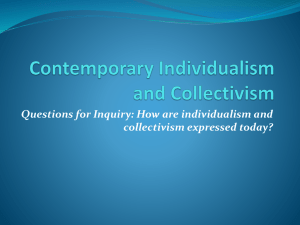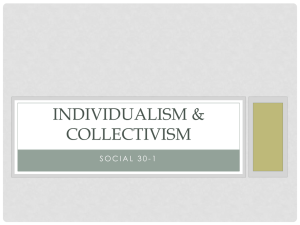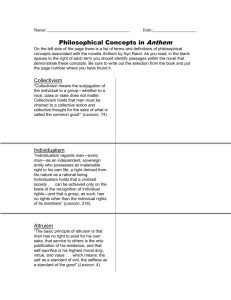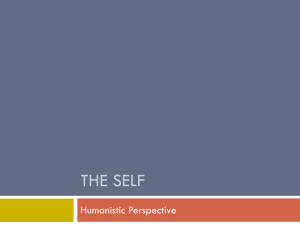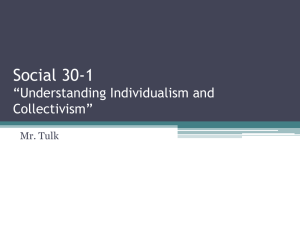Ch 2 Questions
advertisement
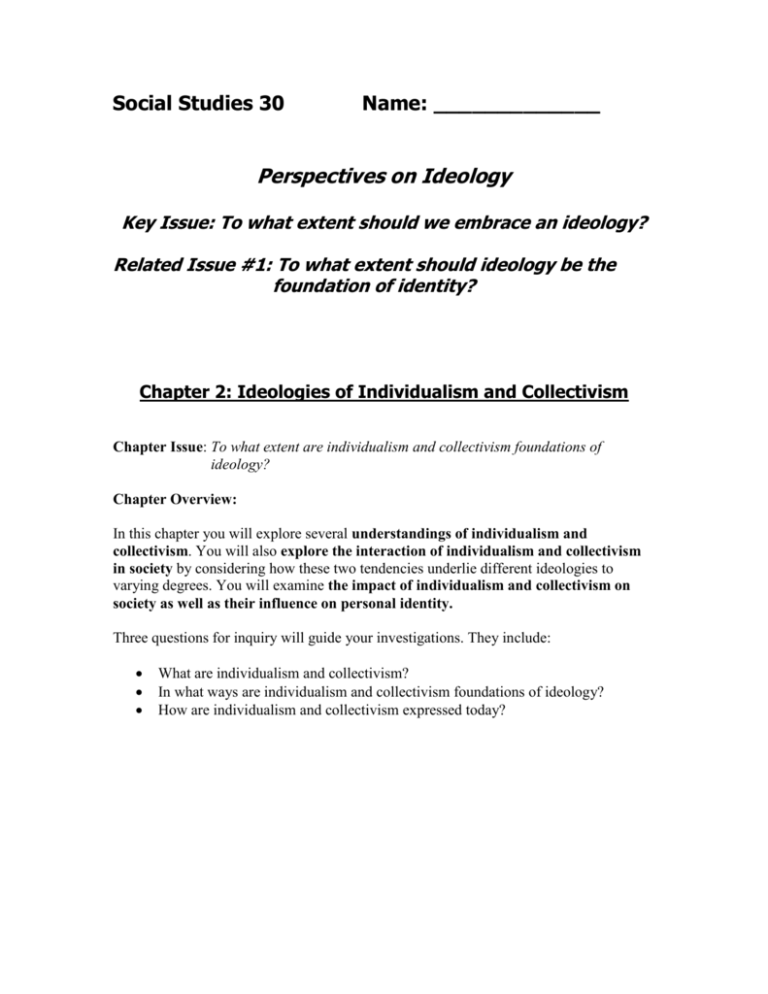
Social Studies 30 Name: _____________ Perspectives on Ideology Key Issue: To what extent should we embrace an ideology? Related Issue #1: To what extent should ideology be the foundation of identity? Chapter 2: Ideologies of Individualism and Collectivism Chapter Issue: To what extent are individualism and collectivism foundations of ideology? Chapter Overview: In this chapter you will explore several understandings of individualism and collectivism. You will also explore the interaction of individualism and collectivism in society by considering how these two tendencies underlie different ideologies to varying degrees. You will examine the impact of individualism and collectivism on society as well as their influence on personal identity. Three questions for inquiry will guide your investigations. They include: What are individualism and collectivism? In what ways are individualism and collectivism foundations of ideology? How are individualism and collectivism expressed today? Key Terms Key Concepts Key People individualism, collectivism, common good, rule of law, individual rights and freedoms, private property, economic freedom, selfinterest, competition, co-operation, public property, collective interest, collective responsibility, adherence to collective norms, nongovernmental organizations (NGOs) The relationship between the individual and society, the growth of individualism through history, the values underlying individualism and collectivism, contemporary expressions of individualism and collectivism Aboriginal Peoples in Canada, Jeff Skoll Introduction: Using the information on page 63, complete the retrieval chart “Characteristics of Ideologies” by identifying characteristics of both individualist and collectivist ideologies. Characteristics of Ideologies Individualist Ideologies Collectivist Ideologies Part One: Understanding Individualism and Collectivism (Pages 64-70) 1. Most individualistic ideologies have a similar understanding of the individuals place in society and stress the importance of ideas such as personal autonomy and self-reliance. Define autonomy and self-reliance. 2. What concepts do all collectivist ideologies stress? 3. Who is thought to be the first to create property laws? What rights did these first laws encompass? 4. Why were the earliest human societies mostly collectivist in nature? 5. Historically, many Canadian Aboriginal people describe their traditional cultures as having a strong sense of the collective. According to Mary Anulik Kutsiq, an Inuit Elder, is this still the case? Why or why not? 6. Both Individualism and Collectivism had roots in the Medieval Period, the Renaissance, and the Protestant Reformation. Complete each chart below by: Listing the most pertinent characteristics of each era that contributed to Individualism or Collectivism. Culminate each chart by identifying if you believe each historical period was characteristic of individualism or collectivism. The Medieval Period Was the Medieval period characteristic of INDIVIDUALISM or COLLECTIVISM? The Renaissance Was the Renaissance characteristic of INDIVIDUALISM or COLLECTIVISM? The Protestant Reformation Was the Protestant Reformation characteristic of INDIVIDUALISM or COLLECTIVISM? Part Two: Principles of Individualism and Collectivism (Pages 71-86) Individualism is one possible foundation of ideology and is a foundation in particular of liberalism, the prevailing ideology in Western democracy. Questions 1-5 will introduce you to the following principles of Individualism and explore how they are manifested in society. 1. rule of law individual rights and freedoms private property economic freedom self-interest competition Rule of Law a) From the glossary, define the term rule of law. b) Would you want to live in a society in which certain members were above the law? Why or why not? c) Are there instances in our society where the rule of law seems to be ignored? Explain fully and cite one example if you can. 2. Individual Rights and Freedoms a) Historically, what groups have been denied the right to vote? b) Do you agree that exclusions today should be made? Explain your answer fully by giving specific examples. c) In Canada, are our Individual Rights and Freedoms guaranteed without limits? d) Read the quote by Pierre Elliot Trudeau, December 21, 1967 (page 74) and answer the question that follows. How does the distinction between private acts and public acts support the values of individualism? 3. Private Property a) During the Enlightenment period in England, how did property laws change? b) How do Canada’s First Nations, Métis, and Inuit people view land and property? c) How does the FNIP perspective on land ownership conflict with the perspective held by the Federal Government? 4. Economic Freedom a) What does economic freedom mean on a personal level? b) What is a free market? c) Why is Canada ranked 10th on the Economic Freedom Index? d) Do you feel it is important to raise Canada’s economic ranking? What would this mean for Canadians? e) Describe the characteristics of a welfare state. 5. Self-Interest and Competition a) According to Adam Smith (18th century Scottish philosopher and economist), in a free market, what he called the invisible hand guides wages and prices. How would the invisible hand help determine the following: i. Prices: ii. Wages: iii. Competition: b) In Smith’s theory, how would allowing individuals to pursue their self-interest benefit society? c) How do Adam Smith and John Kenneth Galbraith differ in their views on the accumulation of wealth? The principles of collectivism are the foundation of ideologies such as communism and socialism. While the principles of individualism formed the basis of the classical liberal ideology that originally guided modern democracies, over time most liberal democracies have evolved and incorporated aspects of collectivism into their political, economic, and social systems. Questions 6-5 will introduce you to the following principles of Collectivism and explore how they are manifested in society. 6. economic equality co-operation public property collective interest collective responsibility adherence to collective norms Economic Equality a) According to the textbook, the meaning of economic equality varies from person to person and ideology to ideology. Review the different meanings outlined on page 80 and answer the question that follows. Which meaning do you believe would be in Canada’s best interest to incorporate the most? Explain fully. b) What does the term progressive taxation mean? c) From the meanings of economic equality on page 80, which two are currently practiced in Canada? d) Do you think we need more economic equality in Canada? Would we have a better society, or would this infringe upon individual freedoms? 7. Co-operation a) _______________ is the means through which members achieve their goals. b) List the examples of co-operatives identified in this section. What are the guiding principles of such co-operatives? 8. Public Property a) What constitutes public property? b) How do the following ideologies view the ownership of property? 9. i. Communist states: ii. Liberal Democracies: Collective Interest a) What does collective interest mean? b) Collective interest forms the basis for which contemporary movements? 10. Collective Responsibility a) What does collective responsibility mean? Give one example of collective responsibility in the contemporary world. b) From the perspective of a totalitarian state, how can collective responsibility be used in a negative way? 11. Adherence to Collective Norms a) What are collective norms? b) List three examples of the “Adherence to Collective Norms” in Canadian society today. c) Explain how censorship can be used as an example of the imposition of a collective norm. d) In George Orwell’s 1984 novel—a totalitarian state exists where collective norms include telling people what to think. Orwell was warning the western world about life in ____________________ in 1949. Part Three: Contemporary Individualism and Collectivism (Pages 87-99) 1. In what ways do you think Jeff Skoll (first president of eBay) is an example of individualism? In what ways do his actions demonstrate collectivism? 2. Describe how an American would view their identity with regards to individualism. 3. a) How are both Canadian and American perspectives on individual success similar? b) How do the Western European perspectives on individual success differ from that shaped by Canada and the United States of America? c) Concerning the issue of providing a social safety net, would you consider Western Europe to be collectivist or individualistic? Explain fully. 4. Even though in North America most people favor an individualist perspective— believing that people should be responsible for their own success—is there any evidence to suggest a collectivist perspective as well? 5. There is no question that John Stanton (founder of the Running Room and Walking Room franchise) and Anita Roddick (founder of the Body Shop franchise) are excellent examples of people who have benefitted from the individualist values of economic freedom and self-interest—entrepreneurs who have achieved great success in the capitalist marketplace. There is evidence to suggest collectivist values shown by both Stanton and Roddick as well. Find and record this evidence of collective values. 6. A modern liberal democracy such as Canada is a good example of a society in which individualist and collectivist values are used side by side. Complete the following retrieval chart by listing examples of both individualism and collectivism. Canada: A Balance Between Individualism and Collectivism Examples of Individualism 7. Examples of Collectivism What part did World War II play in the provision of child care in Canada? 8. The issue of Government involvement in providing child care has been highly debated. The argument centers on providing subsidies directly to individuals or direct government funding of child care. Describe the arguments most likely to be made by a collectivist and an individualist concerning the role government should play in the provision of child care. a) Collectivist: b) Individualist: 9. Study the graph shown in Figure 2-11 on page 93 and answer the questions that follow. a) What does the graph indicate about Canada’s child care policy? Based on this information, draw conclusions about the ideological tendencies of Canadian governments regarding child care. b) Using the same source, can you make any prediction about the extent of the social safety net in Northern Europe? What might the cost be to citizens to maintain this safety net? 10. a) What are Kibbutzim? b) How do Kibbutzim reflect socialist or collectivist principles? 11. Are Non-Governmental Organizations (NGOs) individualist, collectivist, or both? Explain fully.
